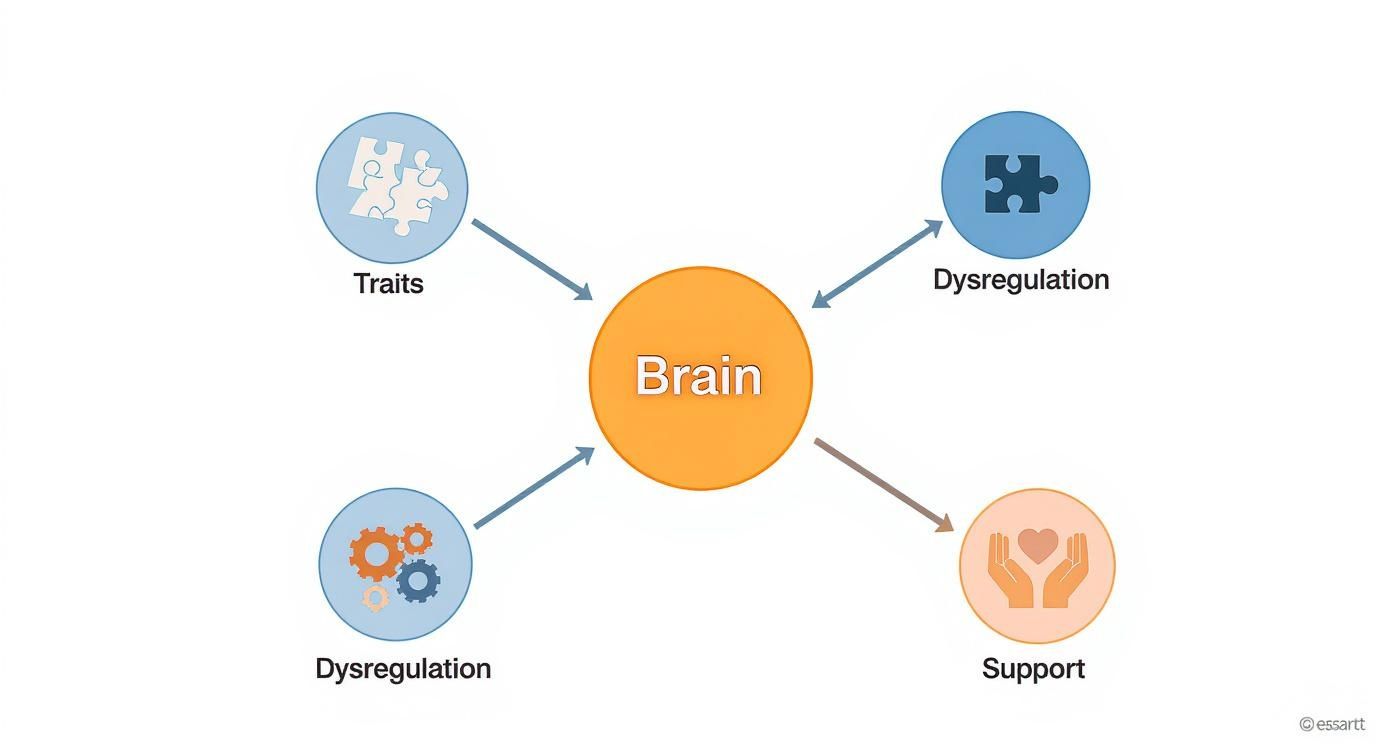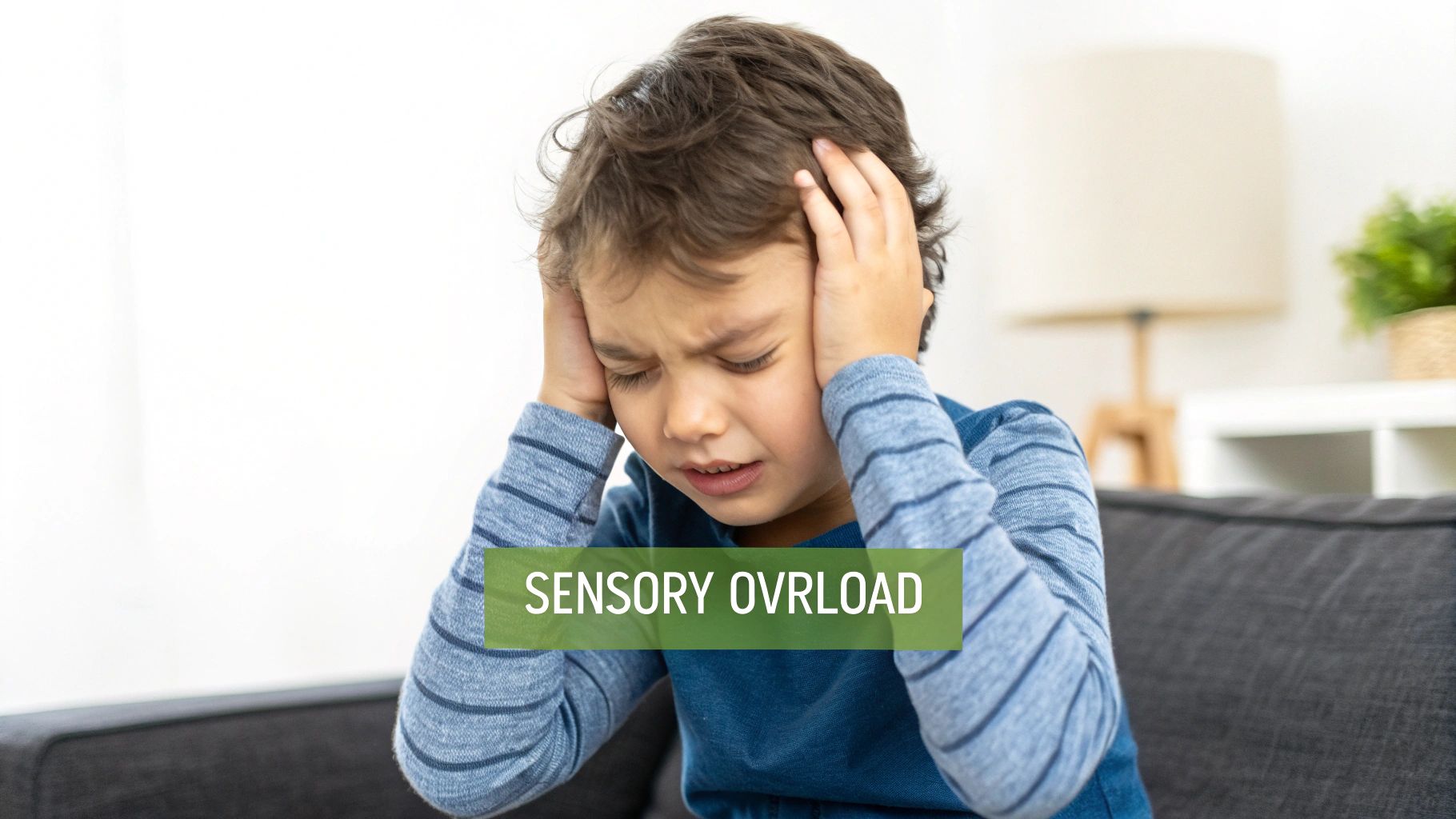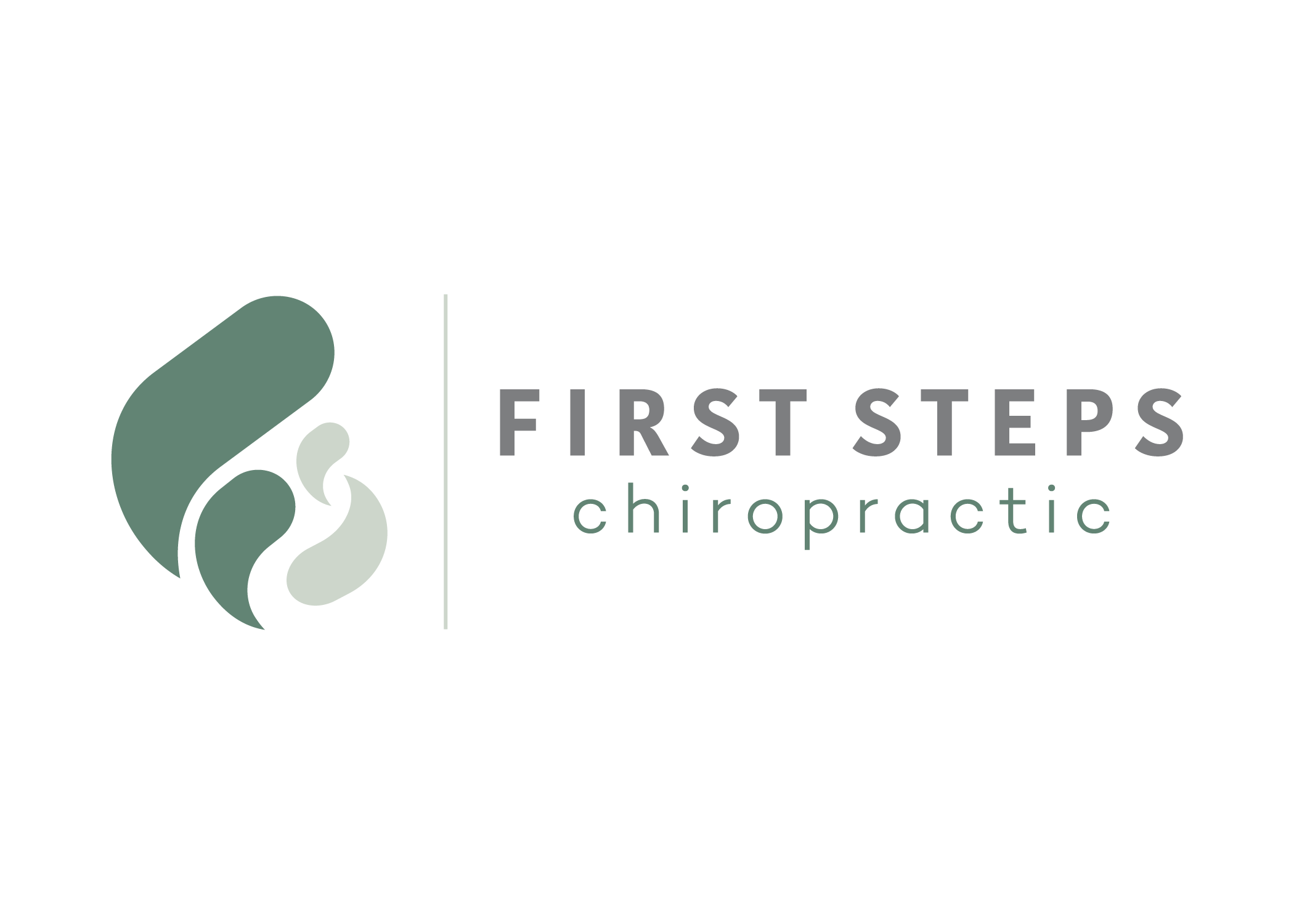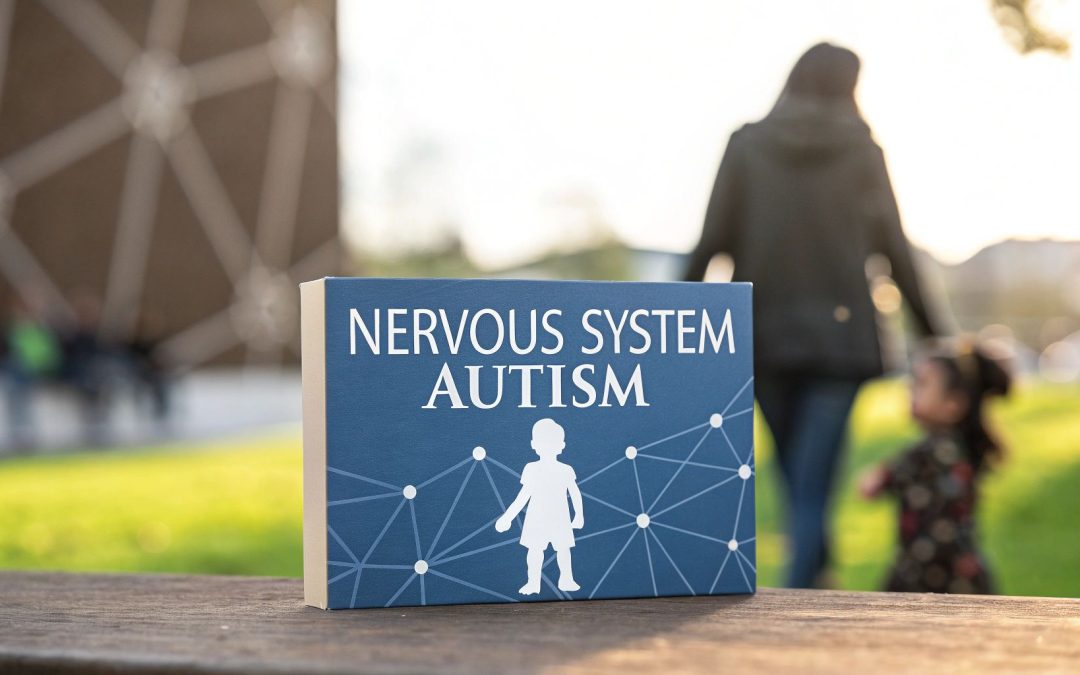It's easy to look at common autistic experiences—like intense sensory sensitivities, emotional meltdowns, and social difficulties—and see them as behavioral problems that need to be managed. But what if we're looking at them all wrong? When you dig a little deeper, you often find these are simply the outward expressions of a dysregulated nervous system.
Understanding this crucial link between the nervous system and autism gives parents a completely new and more compassionate way to find support that actually works.
Reframing Autism Through a Neurological Lens
For so many parents, trying to understand your child’s autism can feel like you're putting together a puzzle with half the pieces missing. You see the behaviors on the surface—the huge reaction to a loud blender, the struggle with any change in routine, or the complete meltdowns that seem to come out of nowhere—but the "why" driving them stays just out of reach.
This is exactly where shifting your view from behavior to biology can change everything.
When we look at these challenges through the lens of nervous system autism, it becomes clear. We’re not dealing with a child who won't cope, but a child who, in that moment, neurologically can't.
The Car Analogy: A Simpler Way to Understand
Think about your child's nervous system as the complex electrical wiring in a car. When everything is working as it should, the signals travel where they need to go, and the car responds just how you'd expect. You flip a switch, the headlights come on. You turn the key, the engine starts. It's smooth and predictable.
Now, imagine a car with a jumbled electrical system. A tiny short circuit could make the radio suddenly blast at full volume, turn the wipers on in the middle of a sunny day, or set off the alarm for no reason at all. The car isn't "misbehaving"—its internal wiring is just getting its signals crossed, reacting in ways that don't seem to match what’s happening outside.
This is the perfect way to think about nervous system autism. An autistic child’s brain is often processing the world at an incredible intensity.
- Sensory Input: The quiet hum of the refrigerator that you barely notice might sound like a deafening roar to them.
- Emotional Regulation: A small disappointment can feel like an absolute catastrophe, triggering an emotional response that seems completely out of proportion.
- Social Cues: The unwritten rules and subtleties of a simple conversation can totally overload their processing circuits, causing them to shut down or get confused.
These are not acts of defiance. They are real, physiological responses from a nervous system that is constantly working overtime just to manage the flood of information pouring in from the world.
By seeing these experiences as neurological, we can shift from a place of frustration to a place of empathy. It lets us ask a much better question: not "How do I stop this behavior?" but "What does my child's nervous system need to feel safe and regulated right now?"
Making this fundamental shift is the most powerful first step you can take. It opens the door to support strategies that work with your child’s neurology instead of fighting against it. Rather than just trying to change the surface-level behaviors, we can start to address the dysregulation underneath, helping to quiet that internal static so your child can feel more organized, secure, and ready to engage with the world on their own terms.
Why the 'Gas Pedal' Stays On in Autistic Children
To really understand the deep connection between the nervous system and autism, we have to look at the body’s automatic control center—the Autonomic Nervous System, or ANS. You can think of the ANS as the behind-the-scenes operator running your child’s internal world. It manages everything from their heart rate and digestion to their breathing, all without them ever having to think about it.
This system has two main branches that are supposed to work in a delicate balance, a lot like the gas and brake pedals in a car.
-
The Sympathetic System (The Gas Pedal): This is the classic 'fight-or-flight' response. It floods the body with energy to handle what it perceives as a threat, making your child alert, focused, and ready for action. It’s absolutely essential for safety and navigating challenges.
-
The Parasympathetic System (The Brake Pedal): This is the 'rest-and-digest' response. It’s what calms the body down, slows the heart rate, and allows for healing, growth, and relaxation. This is the system that helps your child feel safe, settled, and connected.
In a well-regulated nervous system, these two branches work together seamlessly. The gas pedal gets pressed when needed, and then the brake pedal gently engages to bring everything back to a calm baseline. For so many autistic children, though, this balance is thrown off. Their neurological wiring often keeps that 'gas pedal' pushed to the floor, creating a constant state of high alert we call sympathetic dominance.
The Feeling of a Stuck Gas Pedal
Imagine you're driving a car, but the accelerator is stuck. Even when you desperately want to slow down, rest, or just park, the engine keeps revving. It would be completely exhausting, overwhelming, and incredibly stressful. This is a powerful way to understand what many children with nervous system autism experience every single day.
Their systems are constantly primed for danger, even in safe and familiar places like home or school. A minor unexpected noise, a small change in the daily schedule, or even the texture of their shirt can be processed by their brain as a major threat, keeping that fight-or-flight response stuck in the "on" position.
This constant state of physiological stress isn't a choice or a behavioral issue. It is the biological reality of a nervous system that struggles to apply the brakes and find its way back to a state of calm.
This infographic does a great job of visualizing the core pieces of nervous system autism, linking brain function directly to a child's traits, their state of dysregulation, and their need for support.

As you can see, a dysregulated nervous system isn't just a side note—it's a central piece of the puzzle connecting an autistic child's brain to the challenges we see on the surface.
To make this even clearer, let's compare how these two systems operate in a balanced state versus a state of chronic stress.
Comparing Regulated vs. Dysregulated Nervous System States
| State | Balanced Nervous System | Dysregulated Nervous System |
|---|---|---|
| Gas Pedal | Activates for real threats, then disengages | Stuck "on," leading to constant hypervigilance |
| Brake Pedal | Easily engages to promote rest, digestion, and healing | Suppressed and struggles to calm the body down |
| Overall State | Calm, connected, and resilient to daily stressors | Anxious, overwhelmed, and easily triggered into fight-or-flight |
This constant state of overdrive is the root cause of so many of the challenges parents face.
How Sympathetic Dominance Shows Up in Daily Life
When a child’s nervous system is stuck in this high-gear state, it directly fuels the behaviors and struggles that parents see every day. The body is pouring all its resources into survival, which leaves very little energy for anything else.
Here’s how that constant 'gas pedal' can show up:
- Sensory Overload: The brain is already on high alert, so every sight, sound, and touch can feel intensely amplified and overwhelming. This often leads to meltdowns or shutdowns.
- Sleep Difficulties: A body stuck in 'fight-or-flight' mode simply cannot relax into deep, restorative sleep. Many children fight bedtime, wake frequently, or never seem to feel truly rested.
- Emotional Dysregulation: With the stress response constantly simmering, a child has a much shorter fuse. Small frustrations can quickly escalate into huge emotional outbursts because their system is already at its breaking point.
- Digestive Issues: The 'rest-and-digest' system is being overridden, which can lead to common gut problems like constipation, stomach aches, and extremely picky eating.
- Social Withdrawal: Engaging with other people requires a ton of neurological energy. When a child's system is already overloaded, social interaction can feel like too much to handle, causing them to retreat.
Understanding this biological reality is a complete game-changer for parents. It shifts the entire perspective from seeing a child who is being difficult to seeing a child whose body is stuck in survival mode. This simple but profound change in viewpoint opens the door to more empathetic and truly effective ways to provide support—by focusing on calming the nervous system first, rather than just trying to manage behaviors.
How a Dysregulated Nervous System Shapes Sensory Worlds
When a child’s nervous system is stuck with the “gas pedal” pressed down, their brain is constantly on high alert. This state of sympathetic dominance completely changes how they experience the world around them. It’s not just a matter of being a little sensitive; it’s a total recalibration of their sensory reality.
Think of it like this: your brain has a volume dial for every sense—sight, sound, touch, taste, and smell. For most people, that dial stays in a comfortable middle range, filtering out background noise and sensations that don't matter. But for a child with a dysregulated nervous system, that dial is cranked all the way up.
This neurological amplification is why the low hum of a refrigerator can sound like a blaring alarm. It's why the flicker of fluorescent lights can feel like a strobe light at a concert, and why the gentle touch from a loved one can feel startling or even painful.

Hypersensitivity: The World Turned Up to Eleven
Hypersensitivity, or being over-responsive to sensory input, is one of the most common experiences we see linked to nervous system autism. The brain’s natural filter is essentially offline, allowing a flood of raw, unfiltered information to pour in.
This explains so many of the behaviors parents see every day. An autistic child might:
- Cover their ears in a grocery store. The mix of beeping scanners, squeaky cart wheels, and dozens of conversations creates a painful auditory storm.
- Insist on wearing only certain clothes. A seam, a tag, or the texture of a fabric can feel intensely irritating against their skin.
- Be an extremely picky eater. The texture, smell, or even the look of certain foods can be genuinely overwhelming to their senses.
- Avoid bright lights or crowded spaces. Visual chaos quickly overloads their brain's processing capacity, leading to distress and an urgent need to escape.
These aren't choices or acts of defiance. They are genuine, involuntary neurological responses to a world that feels too loud, too bright, and just too much. If you want to dive deeper into the mechanics of this, you can learn more about what is a dysregulated nervous system and how it affects daily life.
Hyposensitivity: The World on Mute
On the other side of the sensory coin is hyposensitivity, which means being under-responsive to sensory input. In this case, the brain’s volume dial seems to be turned way down. The child needs much more intense sensory information just to register it and feel organized in their own body.
A child experiencing hyposensitivity might seem to be constantly seeking sensory experiences to feel regulated. This is their nervous system’s way of trying to get the input it desperately needs to understand where their body is in space and feel grounded.
This drive for sensory input is just as neurological as the avoidance seen in hypersensitivity. Both are signs of a nervous system struggling to find its balance point, or what we call regulation.
This can look like:
- Constant motion: A child who is always spinning, jumping, or crashing into furniture is often seeking intense vestibular and proprioceptive input.
- A high pain tolerance: They might not react to bumps or scrapes that would cause other children to cry because their system isn't registering the sensation clearly.
- Chewing on non-food items: Chewing on shirt collars, pencils, or toys provides powerful oral sensory input that can be incredibly calming.
- Loving tight hugs or weighted blankets: The deep pressure helps their nervous system feel secure, calm, and aware of their body's boundaries.
Understanding both hypersensitivity and hyposensitivity helps us see these behaviors for what they are. They aren't random or meaningless; they are a child’s instinctive attempts to manage an internal world that feels chaotic. By recognizing these sensory signals, parents can move from a place of frustration to one of empathy, ready to provide the right support to help their child’s nervous system finally feel safe.
The Vagus Nerve as a Key to Calming the System
If the sympathetic nervous system is the body's "gas pedal," then what's the brake? The answer lies in a truly remarkable part of our anatomy called the vagus nerve. This isn't just any nerve; it's the main superhighway of the parasympathetic nervous system—the ‘rest-and-digest’ system that brings a sense of calm back to the body.
The vagus nerve is the longest cranial nerve we have, wandering from the brainstem all the way down through the neck, chest, and abdomen. It's connected to nearly every major organ, acting like a two-way communication channel between the brain and the body. Think of it as a direct line managing our heart rate, breathing, and digestion.
When the vagus nerve is activated, it sends a clear message to the body: it's safe to relax. It’s the physiological equivalent of a gentle hand on the shoulder, reassuring the entire system that the threat has passed.

Understanding Low Vagal Tone
Just like a muscle, the vagus nerve has a "tone." Vagal tone is simply a term for how active this nerve is. High vagal tone means the nerve is working efficiently, allowing a child to shift from a state of high stress back to calm with relative ease.
Unfortunately, many children with nervous system autism struggle with low vagal tone. This means their ‘brake pedal’ is weak and doesn't respond quickly. Their bodies have a hard time disengaging from that fight-or-flight response, leaving them stuck in a state of high alert and anxiety long after a stressor is gone. This is a huge piece of the puzzle when it comes to regulation challenges.
The need for effective, neurologically-based support is more urgent than ever. Over the past few decades, the prevalence of Autism Spectrum Disorder has shot up. In the U.S., the rate has nearly quintupled since 2000, and as of 2025, it’s estimated that autism affects 1 in 31 children. These numbers really highlight why finding gentle ways to support these kids is so important. You can dig into more of these autism statistics on abacustherapies.com.
The good news? Just like a muscle, vagal tone can be strengthened. By practicing simple, targeted activities, parents can help their child’s nervous system build the capacity to apply those brakes more effectively.
Family-Friendly Ways to Strengthen the Vagus Nerve
Strengthening the vagus nerve doesn't require any complicated equipment or therapies. In fact, some of the most effective methods are simple, playful activities you can weave right into your daily routine. The goal is to gently stimulate the nerve where it passes through the throat and chest.
Here are a few practical and fun ideas to get started:
-
Humming and Singing: The vibrations from humming or singing directly stimulate the vagal nerve endings in the throat. Put on your child's favorite song in the car and have a sing-along. It’s simple, connecting, and powerful.
-
Gargling: Gargling with water creates a similar vibration at the back of the throat. You can make it a fun game during bathtime or while brushing teeth—see who can gargle the longest!
-
Deep, Slow Breathing: This is a classic for a reason. Encourage your child to take "belly breaths." Have them lie down with a favorite stuffed animal on their belly and ask them to breathe so deeply that the animal gently rises and falls. This activates the diaphragm, which has a direct line to the vagus nerve.
These simple exercises are powerful because they give your child’s body a direct, physical signal that it is safe to calm down. Over time, consistent practice helps build neurological resilience, making it easier for their system to find its way back to balance.
For families curious about how specific therapies can support this process, you can learn more about the connection between the vagus nerve and chiropractic care in our detailed guide.
By focusing on these gentle, at-home techniques, you can start empowering your child with the very tools their nervous system needs to build strength from the inside out. This approach offers a sense of agency, providing practical ways to support regulation and bring a little more calm into your family's life.
How Neurological Chiropractic Care Can Help
Once we understand the roles of the nervous system, sympathetic dominance, and the vagus nerve, the big question becomes: how can we actually support and improve this core communication network? This is where neurologically-focused chiropractic care comes in with a very different approach.
Let's be clear: the goal is never to “treat” or “cure” autism. Instead, our focus is on reducing interference within the nervous system so the body can function better on its own.
Think of it like clearing the static from a radio signal. When the line of communication between the brain and the body is clear, the body’s incredible, built-in ability to regulate and heal itself can finally get to work. The aim is to help the body’s "brake pedal" engage properly, gently guiding the nervous system out of a constant state of stress and toward one of balance and calm.
Targeting Interference in the Nervous System
Neurologically-focused chiropractic care zeros in on tiny misalignments in the spine, especially in the upper neck where the brainstem—the Grand Central Station of nerve communication—is located. When physical, chemical, or emotional stress causes these misalignments (called subluxations), they create interference, messing up the flow of information between the brain and the body.
This interference is often a key reason the sympathetic "gas pedal" gets stuck in the "on" position.
A pediatric chiropractor uses incredibly gentle and specific adjustments to correct these subluxations. These aren’t the forceful manipulations many adults think of; they often involve no more pressure than what you’d use to check a tomato for ripeness.
The purpose of the adjustment is to restore proper motion and alignment, which in turn reduces the tension and interference plaguing the nervous system. This helps improve the vital brain-body connection that is so central to regulation.
By clearing up these communication pathways, we can help improve vagal tone and give the parasympathetic system a fighting chance to do its job. For a child, this can lead to real, noticeable improvements in areas directly linked to nervous system autism, like better sleep, a calmer mood, and more regulated sensory processing.
A Supportive Approach to Underlying Dysregulation
This form of care is a supportive therapy that gets to the root of the physiological stress patterns. It works beautifully alongside other therapies like OT or speech therapy, creating a more solid foundation for all-around progress. When a child’s nervous system is more regulated, they are far better able to engage with and benefit from all the other support in their life.
Sadly, finding the right kind of support is a huge challenge for many families. Access to effective healthcare remains a pressing issue. In the U.S., a staggering one in nine children with autism lacks access to the healthcare services they need. This gap underscores the urgent need for accessible, neurologically-informed approaches that can make a genuine difference. You can find more insights on these challenges from Autism Speaks and their annual report.
The focus on the nervous system offers a path to helping children feel more at home in their own bodies. Our guide on neurologically-based chiropractic for autism takes a much deeper look into the specific techniques we use and the science behind them. By reducing that neurological static, we give children the opportunity to unlock their full potential—not by changing who they are, but by helping their internal systems function with much greater ease and harmony.
Building Your Child's Neuro-Support Team
Figuring out the connection between the nervous system and autism is a huge first step. But the real game-changer is turning that knowledge into a real-world action plan. That starts with assembling the right team to help your child build neurological resilience and truly thrive.
This isn’t about chasing a single magic bullet. It’s about creating a collaborative network of professionals who all get the big picture—the importance of addressing the underlying dysregulation. When therapies are aligned, they work together to create a much stronger foundation for progress. A truly well-rounded team becomes a support system for your child’s entire well-being.
An integrated approach ensures everyone is pulling in the same direction: helping your child’s nervous system feel safe, organized, and ready to take on the world.
Finding a Neurologically-Focused Chiropractor
When you start looking for a chiropractor, it's absolutely essential to find a practitioner who specializes in pediatrics and has advanced training in how the nervous system functions. This is a world away from general chiropractic care that primarily focuses on adult musculoskeletal pain.
Keep an eye out for a PX Docs certification. This is a clear indicator that the chiropractor has invested in extensive postgraduate training specifically for pediatric care. It means they have a deep understanding of neurodevelopmental challenges like autism and use gentle, specific techniques designed for a child’s delicate nervous system.
When you're meeting with a potential provider, don’t be shy about asking direct questions to make sure they're the right fit for your family.
Key Questions to Ask a Potential Chiropractor:
- Do you have specific training in pediatric and neurodevelopmental care?
- What kind of technology, like INSiGHT scans, do you use to actually measure nervous system function?
- Can you walk me through how your adjustments help improve nervous system regulation and vagal tone?
- How do you collaborate with other therapists, like OTs and speech therapists, on a child's care plan?
Creating an Integrated Support System
While neurologically-focused chiropractic care can build a powerful foundation for health, it's most effective when it’s part of a team effort. Other therapies play absolutely vital roles in helping your child build new skills and navigate their world with more confidence.
- Occupational Therapy (OT): OTs are the experts in sensory integration. They can provide targeted activities and strategies to help your child process sensory information more effectively instead of getting overwhelmed by it.
- Speech Therapy: A speech therapist can help with communication challenges, which are often tangled up with a dysregulated nervous system that makes social engagement feel stressful and difficult.
The goal is to create a synergy where each therapy supports and amplifies the others. A calmer, more regulated nervous system makes a child more available and ready for learning in OT and speech sessions. In turn, the skills they gain in those sessions help reinforce that newfound neurological balance.
Navigating this journey can feel overwhelming, and it helps to know you aren't alone. The worldwide estimate of 1 in 100 children diagnosed with ASD highlights just how many families are searching for answers, with diagnostic rates varying quite a bit by region. For parents everywhere, building a strong, knowledgeable team is the most empowering step you can take. You can learn more about these global autism statistics at Motivity.net.
Of course. Here is the rewritten section, crafted to sound like it was written by an experienced human expert, following all the provided guidelines and examples.
Your Questions About Neurologically-Focused Care, Answered
As a parent, you're bound to have questions. It's not just natural—it's necessary. Let's walk through some of the most common things families ask when they're exploring neurologically-focused care for their child.
Is Chiropractic Care Safe For My Child?
This is usually the very first question parents ask, and it’s an important one. We’re not talking about the kind of adjustments you might imagine for an adult. Pediatric chiropractic uses an incredibly gentle and precise touch—often no more pressure than you’d use to check the ripeness of a tomato.
When parents see how soft and specific the adjustments are, they can relax knowing their child is comfortable. The entire approach is designed to honor your child’s developing body and support their overall well-being.
How Do I Know if a Reaction is Neurological or Behavioral?
This is a fantastic question because it gets right to the heart of understanding your child’s world. Think of it this way: a meltdown that happens out of the blue might seem purely behavioral, but if it was triggered by the hum of a refrigerator or the scratchy tag on a shirt, it’s actually a sensory, neurological response. It’s the nervous system saying, "I'm overwhelmed!"—not a sign of defiance.
To get a clearer picture, it helps to become a bit of a detective. Keeping a simple log of what was happening right before a tough moment can reveal powerful patterns.
- Jot down triggers and responses in a notebook—sights, sounds, even textures.
- Compare your daily notes before and after adjustments to spot subtle shifts.
- Share these observations with your chiropractor. It gives us invaluable insight.
Realistic Outcomes You Can Expect
What kind of changes might we actually see?
Every child’s journey is unique, but many parents first notice improvements in areas that affect the whole family’s quality of life. Calmer moods and longer, more restorative stretches of sleep are often the first positive signs.
Over time, you might see that daily transitions, like getting ready for school or leaving the playground, happen with less distress. Many families also tell us they see better focus and a noticeable drop in anxiety as care progresses.
How long does it take to see progress?
While it truly depends on each child’s individual needs, many families begin to spot meaningful shifts within 2–4 weeks of starting consistent care. Think of it like this: each session builds on the last, helping the nervous system learn and hold onto a new, more organized state.
Common early improvements include:
- Better sleep quality
- Fewer sensory-related flare-ups
- Smoother, less stressful daily routines
Planning Your Next Steps
Is there anything we can do at home to support their regulation?
Absolutely! Your efforts at home are a huge piece of the puzzle. Simple, calming routines can reinforce the work we do in the clinic. Things like slow, deep breathing exercises, gentle humming (which stimulates the vagus nerve), or even slow neck stretches can do wonders.
These little practices help strengthen vagal tone throughout the day, which is key for building a more resilient and regulated nervous system.
How often should we plan on coming in?
A typical care plan starts with more frequent visits to build momentum. Most kids begin with 1–2 visits per week for the first month or so. Once their nervous system starts to stabilize and hold its adjustments, we can often shift to 1 visit every 3–4 weeks for maintenance and continued support.
- Weekly visits help create initial momentum and change.
- Maintenance visits are all about protecting and solidifying those gains.
How will I really know if it’s working?
Look for the small things. It's often not one giant leap but a series of subtle, positive changes. You might notice your child flinches less at sudden noises or seems more at ease in a busy grocery store.
These are the clues that tell us their nervous system is re-learning how to process the world without becoming overwhelmed.
- You might notice longer, calmer periods between meltdowns.
- Morning or bedtime routines might feel less like a battle.
- Your child might handle busy environments with more ease.
“Clearing nervous system interference lets children tap into their own natural regulation,” explains a pediatric chiropractic specialist.
Ready to learn more? Visit First Steps Chiropractic to schedule a complimentary consultation and begin your journey toward a more balanced, regulated nervous system for your child.

